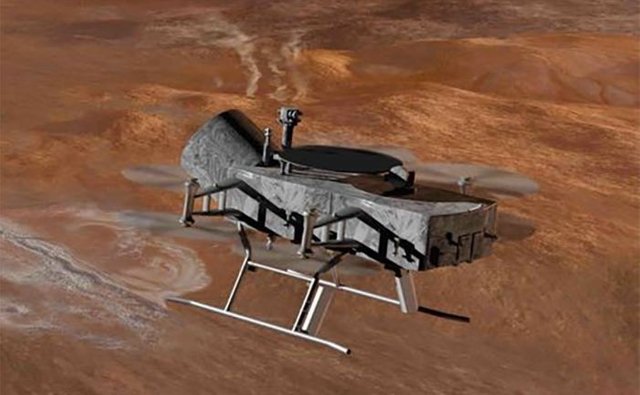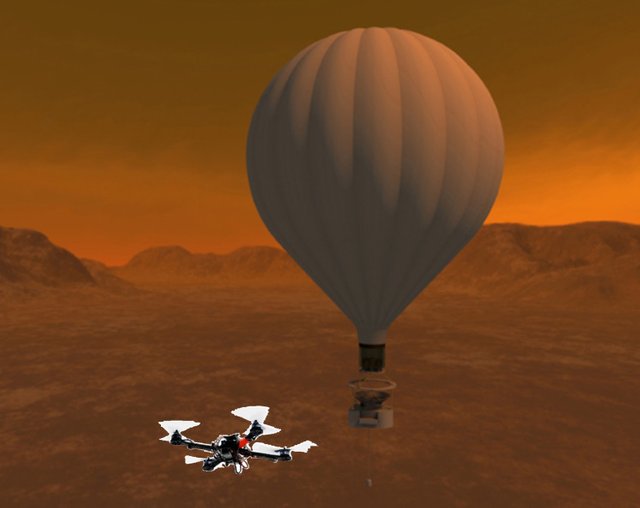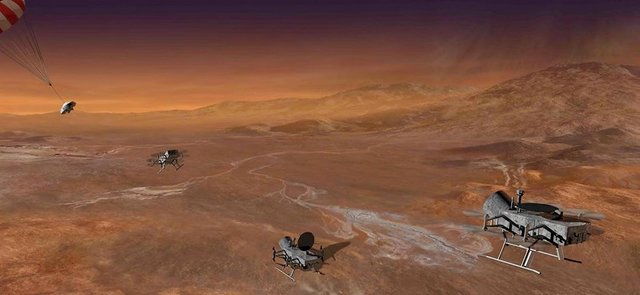Flying drones for Titan exploration
With the success of the Cassini-Huygens mission, coming to end on Sept 15, there are many proposals on the table for follow-up missions that would explore the mountains, giant deserts of dunes of Titan and its methane seas and lakes in greater depth. The challenges that this presents have led to some new concepts, ranging from balloons and landers to floating drones and submarines. The particular attention is given to flying drones. The reason is simple: Titan is perfect world for flying. With its low gravity, which is only 1/7 of Earth's, and dense atmosphere (1,45 of Earth's on the sea level), lifting power is very low. The only problem is cold: surface temperatures are -180 C. So, instead of sending Curiosity style wheeled rover, for Titan, flying drone fits better.

Image: APL/Michael Carroll A proposed eight-bladed drone (aka. "dragonfly") could be ideally suited for exploring Saturn's moon Titan
New proposal for a "Dragonfly" drone by researchers at NASA's JHUAPL that seems interesting: eight-bladed drone, capable of vertical-takeoff and landing, enabling it to explore both the atmosphere and the surface of Titan.The mission concept was proposed by a science team led by Elizabeth Turtle, a planetary scientist from NASA's Johns Hopkins University Applied Physics Laboratory (JHUAPL)
Says Elizabeth Turtle:
Titan's an ocean world with a unique twist, which is the rich and complex organic chemistry occurring in its atmosphere and on its surface. This combination makes Titan a particularly good target for studying planetary habitability. One of the big questions about the development of life is how chemical interactions led to biological processes. Titan's been doing experiments in prebiotic chemistry for millions of years – timescales that are impossible to reproduce in the lab – and the results of these experiments are there to be collected
Dragonfly proposal is based on previous surveys, which considered sending to Titan airship or a balloon. However, balloons are unable to study Titan's rivers, lakes and seas, and cannot get surface samples to conduct chemical analysis.

Image: NASA/STMD Initial conception of balloon mothership and quadrocopter
Initially, Turtle team proposed a mission with balloon-carrier combined with Pathfinder-like lander, but finally, they changed this idea to "Dragonfly" - qaudcopter to conduct both aerial and surface studies.
Much like the Curiosity and upcoming Mars 2020 rovers, the Dragonfly would be powered by a Multimission Radioisotope Thermoelectric Generator (MMRTG), working on plutonium-238 to generate electricity, and can keep a robotic mission going for years.

Image: APL/Michael Carroll
Says Turtle:
Dragonfly would be able to measure compositional details of different surface materials, which would show how far organic chemistry has progressed in different environments. These measurements could also reveal chemical signatures of water-based life (like that on Earth) or even hydrocarbon-based life, if either were present on Titan. Dragonfly would also study Titan's atmosphere, surface, and sub-surface to understand current geologic activity, how materials are transported, and the possibility of exchange of organic material between the surface and the interior water ocean
This sort of flying drones could become the mainstay for studying the bodies with atmospheres. Currently, NASA is considering idea to include tiny "Scout" helicopter to the next mission Mars 2020 with rover - still unnamed twin brother of Curiosity.
For further reading: https://phys.org/news/2017-05-titan-ripe-drone-invasion.html